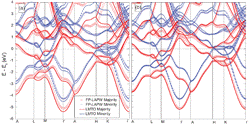Department of Physics and Astronomy: Publications and Other Research

Kirill Belashchenko Publications
Document Type
Article
Date of this Version
1999
Citation
J. Phys.: Condens. Matter 11 (1999) 10593–10620. Printed in the UK; PII: S0953-8984(99)06217-7
Abstract
The earlier-described master equation approach to configurational kinetics of nonequilibrium alloys is applied to study L12-type orderings in FCC alloys. We describe the kinetic tetrahedron cluster-field method which generalizes a similar method used for equilibrium systems to the case of non-equilibrium alloys. The method developed is used to simulate A1 → L12 and A1 → A1 + L12 transformations after a quench of an alloy from the disordered A1 phase to the single-phase L12 state or the two-phase A1 + L12 state for a number of alloy models with both short-range and long-range interactions. Simulations of the A1 → L12 transition show a sharp dependence of the microstructural evolution on the type of interaction, and particularly on the interaction range. The simulations also reveal a number of peculiar features in both the transient microstructures and the transformation kinetics, many of them agreeing well with experimental observations. Microstructural evolution under A1 → A1 + L12 transition was found to be less sensitive to the type of the finite-range (‘chemical’) interaction, while in the presence of elastic interaction this evolution shows a number of specific features which were earlier discussed phenomenologically by Khachaturyan and co-workers and are illustrated by our simulations. We also consider the problem of the occurrence of a transient congruent ordering under A1 → A1+ L12 transformation and discuss the microstructural features of this stage.


Comments
Copyright 1999 IOP Publishing Ltd. Used by permission.